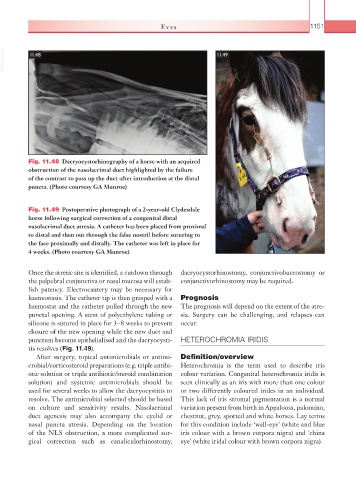Page 1176 - Equine Clinical Medicine, Surgery and Reproduction, 2nd Edition
P. 1176
Eyes 1151
VetBooks.ir 11.48 11.49
Fig. 11.48 Dacryocystorhinography of a horse with an acquired
obstruction of the nasolacrimal duct highlighted by the failure
of the contrast to pass up the duct after introduction at the distal
puncta. (Photo courtesy GA Munroe)
Fig. 11.49 Postoperative photograph of a 2-year-old Clydesdale
horse following surgical correction of a congenital distal
nasolacrimal duct atresia. A catheter has been placed from proximal
to distal and then out through the false nostril before suturing to
the face proximally and distally. The catheter was left in place for
4 weeks. (Photo courtesy GA Munroe)
Once the atretic site is identified, a cutdown through dacryocystorhinostomy, conjunctivobuccostomy or
the palpebral conjunctiva or nasal mucosa will estab- conjunctivorhinostomy may be required.
lish patency. Electrocautery may be necessary for
haemostasis. The catheter tip is then grasped with a Prognosis
haemostat and the catheter pulled through the new The prognosis will depend on the extent of the atre-
punctal opening. A stent of polyethylene tubing or sia. Surgery can be challenging, and relapses can
silicone is sutured in place for 3–8 weeks to prevent occur.
closure of the new opening while the new duct and
punctum become epithelialised and the dacryocysti- HETEROCHROMIA IRIDIS
tis resolves (Fig. 11.49).
After surgery, topical antimicrobials or antimi- Definition/overview
crobial/corticosteroid preparations (e.g. triple antibi- Heterochromia is the term used to describe iris
otic solution or triple antibiotic/steroid combination colour variation. Congenital heterochromia iridis is
solution) and systemic antimicrobials should be seen clinically as an iris with more than one colour
used for several weeks to allow the dacryocystitis to or two differently coloured irides in an individual.
resolve. The antimicrobial selected should be based This lack of iris stromal pigmentation is a normal
on culture and sensitivity results. Nasolacrimal variation present from birth in Appaloosa, palomino,
duct agenesis may also accompany the eyelid or chestnut, grey, spotted and white horses. Lay terms
nasal puncta atresia. Depending on the location for this condition include ‘wall-eye’ (white and blue
of the NLS obstruction, a more complicated sur- iris colour with a brown corpora nigra) and ‘china
gical correction such as canaliculorhinostomy, eye’ (white iridal colour with brown corpora nigra).

